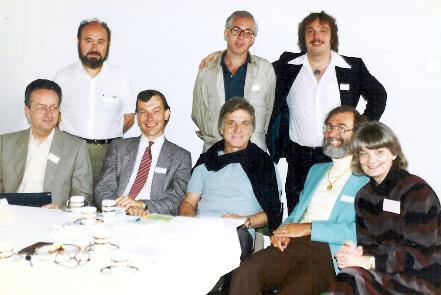Stories
The brain mechanisms of aggression
Motivational systems of social behavior
International Society for Research on Aggression
Behavior Genetics Association Ethics Committee
The World Wide
Runners Club
for Peace
United Nations University for Peace
Charlie Robbins, barefoot runner
* * *
In 1978, the International Society for Research on Aggression was held at the National Academy of Sciences in Washington under the Presidency of David Hamburg, a psychiatrist from Stanford University. At the meeting, frustrated by what seemed to me the irrelevance of their discussions to the wars and threats of war around us, I stood up and demanded that the meeting take some kind of stand on these matters. Hamburg responded by suggesting that there could be an ethics committee and he named one of his students, Burr Eichelman, to be its co-chair along with me.
Burr, like his mentor Hamburg, agreed with US government policy, including its military posture, but he and I got along personally and we applied for and obtained a grant from the National Science Foundation. This paid for several meetings of the committee, several commissioned papers on the ethics of aggression research, and travel to the ISRA meetings in Haren (the Netherlands) in July, 1980, where we scheduled a special session for a discussion of ethical issues.
The Haren meeting was a great success. The ethics session was the best attended of the meeting and was filled with lively discussion, including Santiago Genoves from Mexico and Martin Ramirez from Spain, both of whom would later play key roles in the development of the Seville Statement on Violence. Always a colorful character, Santiago sent me very rough notes and got me to "ghost-write" the paper on the ethics of aggression research that he published in a special issue of the journal Aggressive Behavior. The film he had commissioned, including an animation of Picasso's painting of Guernica, was a big hit at the Haren meeting.
I have kept the letters I wrote as secretary of the ISRA Ethics Committee in 1979 and 1980. In October 1980, the Committee met at Killam's Point in Branford, Connecticut. Burr Eichelman, Jeffrey Goldstein, Tammy Powledge and Dan Wikler and I spent the weekend at this beautiful retreat on the sea and agreed to set up symposia at the Mexico City meeting of ISRA to be held in 1982 and to suggest that we give birth to two new committees, one for working at the UN (my responsibility) and one for working with the media (Jeff Goldstein's responsibility), while Burr would retain responsibility for the Ethics Committee. What I remember most about that meeting was talking with Burr Eichelman about splitting with our wives. He had already met a new woman. I had not yet met Lindsay, but ironically, three years later we bought a house with a view of Killam's Point, which I am looking at as I write this.
The Mexico City meeting of August 1982 was hosted by Santiago Genoves in an old hotel with a mural by Siquieros in the lobby. The meetings formally adopted our proposal and established a UN Committee which would be my responsibility for the next few years. I keep an great deal of correspondance from that committee, beginning even before the Mexico City meetings, both individual letters and at least 15 editions of a "committee of correspondance" to the entire committee, which was essentially replaced by the Seville Statement Newsletter after May 1986.

Key players in ISRA. Back row from left to right: Martin Ramirez, Jeff Goldstein and James Cheek; front row: Pierre Karli, Jo Groebel, Santiago Genoves, myself and Kirsti Lagerspetz
My first endeavor with the UN Committee was to support the development of the United Nations University for Peace at the UN along with Neal Miller who had been one of the founding members of ISRA. I had started this already in 1980, which had led to my work registering ISRA as an official ECOSOC NGO at the United Nations, which was formally achieved in May of 1983.
We had to overcome opposition to the United Nations among the US members of ISRA which culminating in a mailed questionnaire to the ISRA membership. The results, tabulated at the 1984 meetings in Finland found that the UN involvement was supported by 71 and opposed by 39 members
By mid-1983, the UN committee of correspondance had begun to deal with the proposal for a UNESCO statement on violence patterned after its previous statements on race. The idea had already been raised with me by Santiago Genoves in correspondance soon after the 1980 meetings in Haren, and Pierre Karli, past President of ISRA, had entered into discussions on our behalf at UNESCO in Paris. The further development of this idea is discussed on a page fully devoted to the origins of the Seville Statement on Violence.
Although my engagement with the Seville Statement on Violence and later UNESCO took the place of my involvement with ISRA for many years, I returned to the international meeting of ISRA in Valencia in 2000 as a plenary speaker regarding the International Year for the Culture of Peace. My remarks were later published by Elsevier in a volume of papers from that meeting.
 |
Stages
1986-1992
Fall of Soviet Empire
1992-1997
UNESCO Culture of Peace Programme